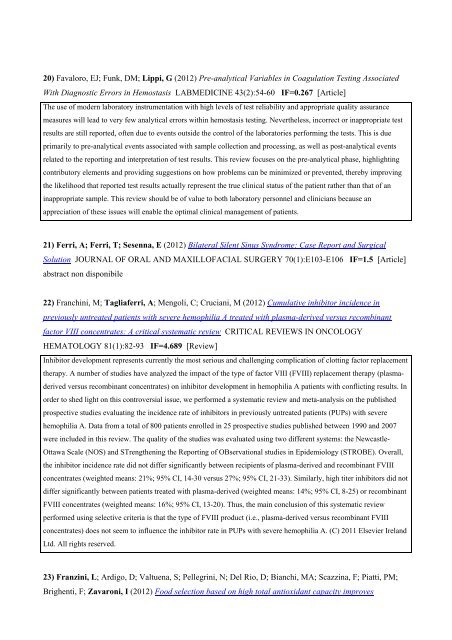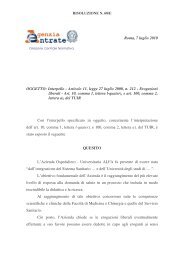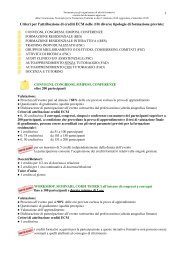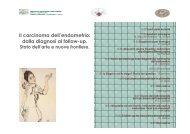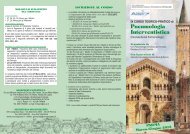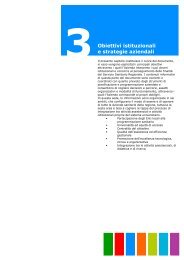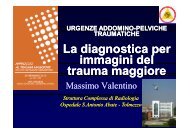COLLEGIO DI DIREZIONE - Azienda Ospedaliera di Parma
COLLEGIO DI DIREZIONE - Azienda Ospedaliera di Parma
COLLEGIO DI DIREZIONE - Azienda Ospedaliera di Parma
Create successful ePaper yourself
Turn your PDF publications into a flip-book with our unique Google optimized e-Paper software.
20) Favaloro, EJ; Funk, DM; Lippi, G (2012) Pre-analytical Variables in Coagulation Testing Associated<br />
With Diagnostic Errors in Hemostasis LABME<strong>DI</strong>CINE 43(2):54-60 IF=0.267 [Article]<br />
The use of modern laboratory instrumentation with high levels of test reliability and appropriate quality assurance<br />
measures will lead to very few analytical errors within hemostasis testing. Nevertheless, incorrect or inappropriate test<br />
results are still reported, often due to events outside the control of the laboratories performing the tests. This is due<br />
primarily to pre-analytical events associated with sample collection and processing, as well as post-analytical events<br />
related to the reporting and interpretation of test results. This review focuses on the pre-analytical phase, highlighting<br />
contributory elements and provi<strong>di</strong>ng suggestions on how problems can be minimized or prevented, thereby improving<br />
the likelihood that reported test results actually represent the true clinical status of the patient rather than that of an<br />
inappropriate sample. This review should be of value to both laboratory personnel and clinicians because an<br />
appreciation of these issues will enable the optimal clinical management of patients.<br />
21) Ferri, A; Ferri, T; Sesenna, E (2012) Bilateral Silent Sinus Syndrome: Case Report and Surgical<br />
Solution JOURNAL OF ORAL AND MAXILLOFACIAL SURGERY 70(1):E103-E106 IF=1.5 [Article]<br />
abstract non <strong>di</strong>sponibile<br />
22) Franchini, M; Tagliaferri, A; Mengoli, C; Cruciani, M (2012) Cumulative inhibitor incidence in<br />
previously untreated patients with severe hemophilia A treated with plasma-derived versus recombinant<br />
factor VIII concentrates: A critical systematic review CRITICAL REVIEWS IN ONCOLOGY<br />
HEMATOLOGY 81(1):82-93 IF=4.689 [Review]<br />
Inhibitor development represents currently the most serious and challenging complication of clotting factor replacement<br />
therapy. A number of stu<strong>di</strong>es have analyzed the impact of the type of factor VIII (FVIII) replacement therapy (plasmaderived<br />
versus recombinant concentrates) on inhibitor development in hemophilia A patients with conflicting results. In<br />
order to shed light on this controversial issue, we performed a systematic review and meta-analysis on the published<br />
prospective stu<strong>di</strong>es evaluating the incidence rate of inhibitors in previously untreated patients (PUPs) with severe<br />
hemophilia A. Data from a total of 800 patients enrolled in 25 prospective stu<strong>di</strong>es published between 1990 and 2007<br />
were included in this review. The quality of the stu<strong>di</strong>es was evaluated using two <strong>di</strong>fferent systems: the Newcastle-<br />
Ottawa Scale (NOS) and STrengthening the Reporting of OBservational stu<strong>di</strong>es in Epidemiology (STROBE). Overall,<br />
the inhibitor incidence rate <strong>di</strong>d not <strong>di</strong>ffer significantly between recipients of plasma-derived and recombinant FVIII<br />
concentrates (weighted means: 21%; 95% CI, 14-30 versus 27%; 95% CI, 21-33). Similarly, high titer inhibitors <strong>di</strong>d not<br />
<strong>di</strong>ffer significantly between patients treated with plasma-derived (weighted means: 14%; 95% CI, 8-25) or recombinant<br />
FVIII concentrates (weighted means: 16%; 95% CI, 13-20). Thus, the main conclusion of this systematic review<br />
performed using selective criteria is that the type of FVIII product (i.e., plasma-derived versus recombinant FVIII<br />
concentrates) does not seem to influence the inhibitor rate in PUPs with severe hemophilia A. (C) 2011 Elsevier Ireland<br />
Ltd. All rights reserved.<br />
23) Franzini, L; Ar<strong>di</strong>go, D; Valtuena, S; Pellegrini, N; Del Rio, D; Bianchi, MA; Scazzina, F; Piatti, PM;<br />
Brighenti, F; Zavaroni, I (2012) Food selection based on high total antioxidant capacity improves


